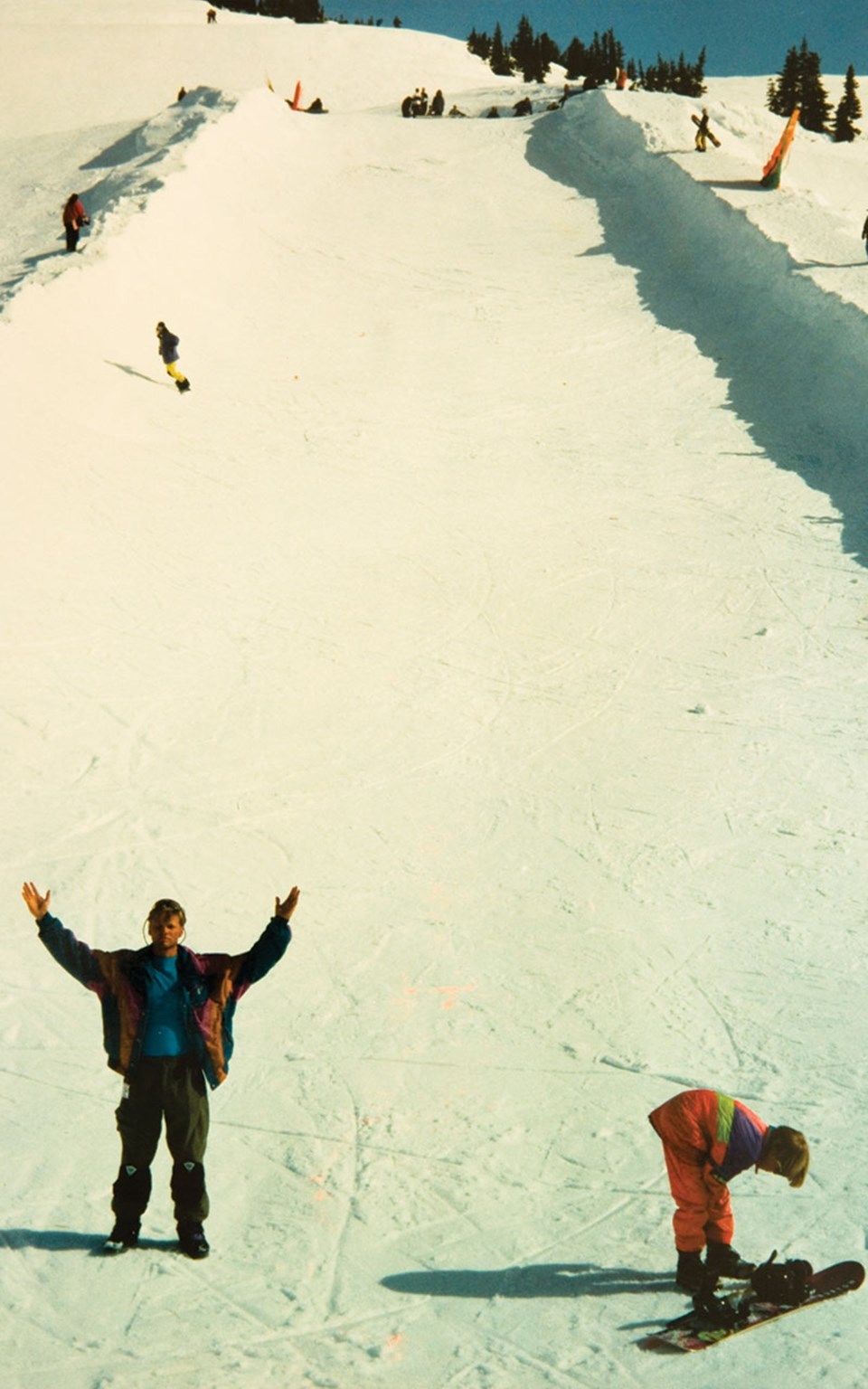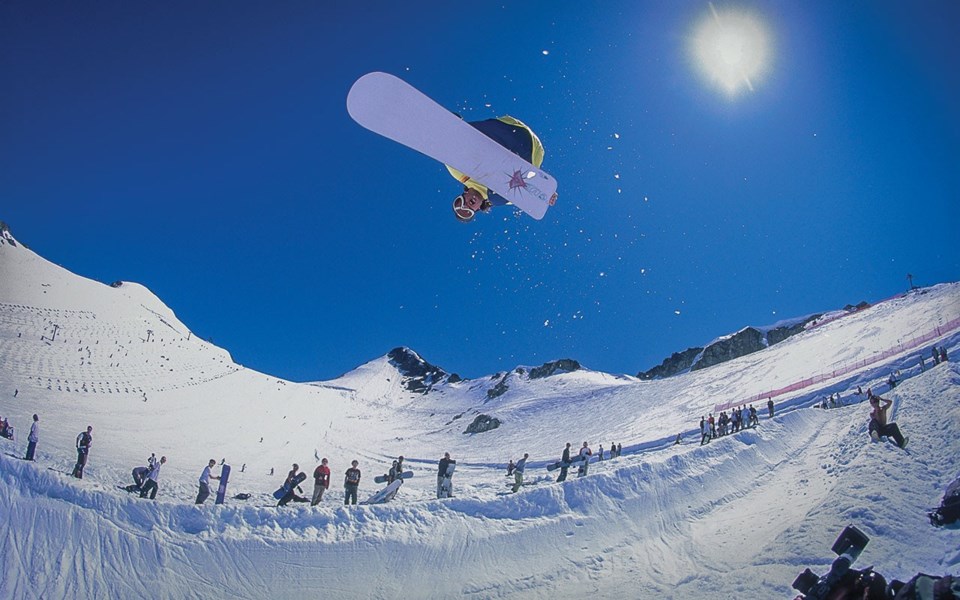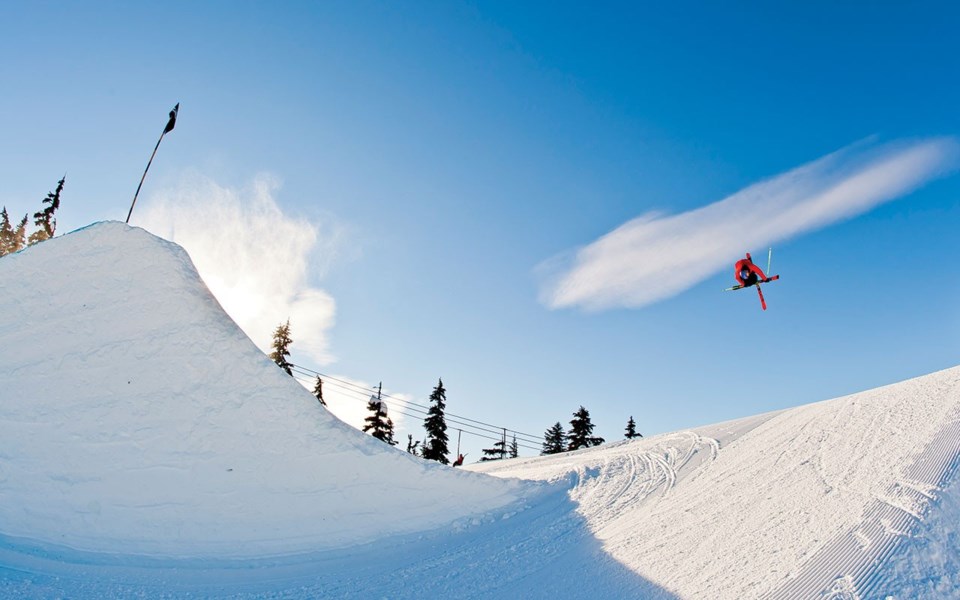Few runs on Whistler Blackcomb inspire the same type of devotion as the resort鈥檚 terrain parks.
And really, why would they?
Where else can you (if you're so inclined/skilled) throw a corked 720 over a perfect, 20-metre kicker with a pitch-perfect transition?
Or boardslide a giant S-shaped rail that looks like it belongs in a video game?
Or dick around with your friends on the same medium-sized kickers that you've hit 4,000 times before?
For the past 25 years, the mountain's terrain parks have grown and evolved with the times, proving to be an outstanding incubator of progress and thrill-seeking鈥攖he kind of thing that draws droves of young people to cram into crusty, overpriced double-rooms and live the dream for a season or two...or many more.
And when you think about it, what would this town look like without its world-class terrain parks?
Over the years, WB's parks have been immortalized through magazine and video coverage, shining a light on some of the extraordinary riding that's taken place within them.
For pro snowboarder Craig McMorris, WB's terrain parks were always considered the "holy land" of Canadian snowboarding.
McMorris recalls the first time he and his brother Mark (Olympic medallist, all-around shred God) visited the Blackcomb park for the first time, about a dozen years ago.
Growing up in prairie-flat Regina, the boys had ridden some big jumps during trips to resorts in Alberta, but their first few runs hitting the massive jumps down the advance line were special.
"I just remember that it was like the craziest, most groundbreaking experience for me and Mark," recalls McMorris, who, along with his brother, was a member of the Saskatchewan Snowboard Team at the time.
"We always had it in our minds that the jumps are built so well that you could do anything and not get hurt," he says.
"It was perfect. It was the ultimate place to be."
Years later, McMorris鈥攚ho has put out several heavy parts in recent years, including the opening segment of 2016's The Manboys Movie, and features in all three Shred Bots films鈥攕ays he still can't resist the allure of the resort's terrain parks.
"I have lived here for six or seven years, and probably 95 per cent of the runs [I've done] have been through the Blackcomb or Whistler park," he recalls. "I'm not even exaggerating. I go up there, and that's what I do."
IN THE BEGINNING...THERE WAS BLACKCOMB
In many ways, Whistler's first terrain park was a response to developments that were already underway at Blackcomb and in the wider world of snowboarding.
Well before merging with Whistler Mountain in 1997, Blackcomb was an early adopter of snowboarding, and there is a storied legacy of riders building hand-dug guerrilla halfpipes and kickers on the mountain predating the construction of a terrain park.
Whistler-based photographer Scott Serfas recalls building jumps around Blackcomb at the time鈥攖o the dismay of ski patrol.
"I just remember hitting jumps and getting in trouble," says Serfas, who would go on to become senior photographer for Transworld SNOWboarding (a position he held until 2016) and capture many of the sport's most iconic images.
"Ski patrol would always sort of give you shit鈥攂ut it got to the point where they would say, 'Make sure someone is watching, at least, so you're not hitting anyone.'"
According to Brian Finestone, WB's current parks manager, Blackcomb Mountain always had a more accommodating approach to riders "enhancing" natural features than Whistler, which banned snowboarders until 1990.
"On Whistler, there were some notorious patrollers that hunted [jumps] down and smashed them to the ground," remembers Finestone, who started working for Blackcomb as a lift operator in 1992.
At the time, snowboarding was growing by leaps and bounds, and there was clearly a demand for a dedicated place for freestyle riders.
But according to local legend Hugh Smythe鈥攚ho began working as a patroller on Whistler as a fresh-faced teenager in 1966 before helping found Blackcomb Mountain and playing a key role in its merger with Whistler Mountain鈥攖he decision to invest in a terrain park was a strategic one.
Back then, Whistler was known as a racing mecca, recalls Smythe, having held a series of extremely popular World Cup downhill events.
"So what we decided, from a competitive or strategic standpoint, was that we'll go after some of the other more youthful endeavours, being freestyle and terrain-park snowboarding," he says.
"It was a very strategic marketing decision that we made."
Yet despite Smythe's vision, Blackcomb's snowboard park didn't sit well with everyone.
Smythe remembers how he personally experienced "blowback" for the decision to place the park on Choker, a popular run among the mountain's skiers.
"For skiers, snowboarding was new, and they didn't like having the snowboarders [on one of their preferred trails]," he says. "It wasn't all roses."
TRIAL BY FIRE (AND ICE)

The Kokanee Snowboard Park first appeared on the Blackcomb trail map in the 1994-95 winter season.
But the park officially launched the year prior, says Stu Osborne, who was named Blackcomb's "snowboarder co-ordinator" in the 1992-93 season. That early park consisted of a "hand-dug halfpipe" that sat just above where the alpine shop currently sits and two jumps at the bottom of Blackcomb's Catskinner bumps.
Osborne, who later became the terrain park supervisor, describes the "snowboarder co-ordinator" role as a sort of all-encompassing position that allowed him to dedicate his time to growing the sport.
"My goal was to basically do everything we could to support the sport, from events, to facilities to instruction to marketing, to everything," says Osborne.
In addition to getting the park up and running, Osborne also oversaw the development of a "ride guide" specifically for snowboarding, which identified all the fun spots around the mountain.
In advance of the 1994-95 season, Blackcomb purchased its first pipe dragon, a piece of specialized grooming equipment that could be used to carve out a halfpipe.
The purchase, says Osborne, was nothing short of "revolutionary," making the arduous task of hand-digging a thing of the past.
"It created a much more uniform transition and created corduroy after the shaping cut," explains Osborne.
Twenty-five years later, WB now has a dedicated crew of groomers whose sole focus is the terrain parks. With meticulous precision, the highly skilled operators use the machines to dig up and place heavy rails and build massive jumps from a mix of natural and man-made snow.
Their abilities are forged through hours upon hours of practice.
Steve Petrie holds the distinction of being the Blackcomb park's first dedicated groomer.
In general, the other groomers were not interested in going in the park, recalls Petrie, who began in the 1994-95 season.
"I was riding in [the park] with my friends every day, so I was like, 'Oh ya, I'll work in there and try to make it better.'"
Petrie describes those early days of park building as one might expect. Experimentation marked those early years, with the park crew mostly working by the seat of their pants, building as they went through a process of trial and error.
"Nobody really knew anything about [terrain] parks," recalls Petrie. "You could show up one day and there would be like three or four new jumps that no one had ever seen before."
Over the years, Blackcomb's park grew, expanding to take up all of Choker.
"We went from just having that small area on Choker to taking the whole run because the demand was there," recalls Petrie. "It just seemed to grow and grow every year."
After 11 years with the parks crew, Petrie went on to start Pemberton-based Arena Snowparks, which now builds the lion's share of WB's rails, in addition to supplying resorts across North America.
Terrain parks, explains Petrie, are an evolving thing, with resorts demanding different types of features from year to year.
"Every season, we have no idea what the orders are going to look like," says Petrie.
"Like last year, it was all fat bars, and then this year, it's been boxes: boxes, boxes, boxes."
听
SKIERS VS. RIDERS
The beef between skiers and snowboarders in those early days of the terrain park could be sizzling hot. In the beginning, the terrain park鈥攐r, rather, snowboard park鈥攚as the domain of snowboarders, a place where they could hit jumps in a controlled area.
Blackcomb, notes Osborne, was explicit about keeping skiers out, with signage that put it bluntly: "No skiers allowed."
According to Finestone, many snowboarders felt that skiers had a way of ruining the terrain, that they would do stupid things like ski down the centre of a halfpipe, creating a mogul field that ruined riders' flow.
"Whether or not it [actually] happened, that was the complaint," Finestone says.
With their pariah status, skiers had to crash the pipe if they wanted to ride it.
"I remember, there would be like five or six guys who would be like, 'Yeah, let's do a run through the pipe,'" recalls Finestone. "They would go, '3-2-1, go!' and [drop] in a big train," snaking all of the snowboarders.
"Then they would just kind of hop out the other end and disappear, because if they stuck around, it would often get aggressive."
There were literally "fistfights" on the decks of the halfpipe, recollects Finestone.
Osborne also recalls the "tension."
"And I said, 'You know what, why are we segregating?' I mean, who was jumping first?
"The last thing I wanted was for things to go sideways, like it was on Whistler."
To ease things, Blackcomb quickly integrated the park, changing from a snowboard park to a terrain park within the first couple years of its existence.
Looking back, it's remarkable how much things have changed.
Sure, there may still be the odd snowboarder with a deep-seated grudge against skiers, and vice versa. But for the most part, these days, skiers and boarders co-exist peacefully.
"Yeah, it was a different era," quips Finestone.
"At least at this resort, there is no 'us' and 'them' ... Everyone's intermingling."
BEST OF BOTH WORLDS
In 1998, Whistler got its own terrain park.
Taken together, the Blackcomb and Whistler terrain parks offer a handful of lines of varying difficulty, offering up what Finestone calls a "continuum of progression" for riders.
"It gives you the opportunity to learn how to jump safely," he explains.
In other words, it gives riders the ability to slowly work their way up through the various grades of jumps鈥攕mall, medium, large, and (if need be) extra large鈥攇aining more and more control over their skis or board along the way.
Though it might be a tad steep for many people's liking, Blackcomb's park has the bigger jumps and gnarlier rails.
Whistler's has a mellow pitch that allows riders to flow through fun, medium-sized features.
Riders can hit up the Whistler park in the morning and then hop on the Peak 2 Peak to take in some sunny afternoon laps in the Blackcomb park.
"A lot of people start on one side, and then bump over to the other, chasing the sun," says Finestone.
McMorris鈥攚ho, like a lot of pros, uses the features to dial-in tricks for street or backcountry sessions鈥攕ays there is a "perfect balance" between the two parks.
"They really pride themselves on having something that will challenge everybody, no matter who you are," he adds.
TESTING GROUNDS
Over the years, the Blackcomb park and its super pipe have served as a training ground for scores of Canadian athletes.
Twice a year鈥攊n January (before the X-Games) and at the end of the season鈥攖he Blackcomb park hosts training camps for the Canadian national snowboard team.
"What is beautiful about it is that it's not exclusive," says Finestone. "So we build these features for the national team to train on, but they're also open for anybody who is a local.
"So what we have is the ripple effect of local kids having access to these world-class training facilities. They may not be part of this elite team, but they're hitting the same features, and they're developing and progressing themselves at a rate that we wouldn't be able to offer if we didn't have the partnership."
Remarking on the legacy of WB's terrain parks, Finestone says it's notable that "this small offering to keep snowboarders out of trouble" managed to morph into "18 Olympic medalling events."
McMorris, who was on the Canadian national team from 2011 to 2014, says there is a direct connection between those national snowboard camps and Canada's success on the Olympic podium.
"You can attest those jumps to winning medals for Canada," he says. "Max Parrot has been here; he got silver. Mark's got two bronze. Seb 'Toots' [Toutant] got a gold medal in big air.
"That's gold, silver and bronze for guys who have come to these jump camps and ridden these jumps quite a bit."
The level of riding in WB's terrain parks has gotten to the point where watching an above-average 14-year-old is enough to make your jaw drop鈥攍et alone seeing a top pro ride.
A trip through either park in the spring, when the transitions soften up in the afternoon and everyone has their tricks dialed, is a thrilling experience, and not just for those hitting the features.
There is something profoundly cool about this subset of the skiing and snowboarding population who show such dedication, who turn up each day with an unyielding desire for progress.
"It's a place where I can hone my craft and get better at snowboarding, and that's the most rewarding thing," remarks McMorris.
What's beautiful is that this is as true for him as it is for anyone else who spends a lot of time riding the park, whether that be a seasonal worker trying to land their first 360 or a weekend warrior wanting to butter a box.
Riding the park isn't about $800 jackets, or riding the same runs with your friends that might be enhanced with some fresh snow.
It's about pushing mental and physical limits (despite the very real possibility that you could injure yourself in the process).
Like McMorris, I too remember my first trips through the Whistler park, during an annual trip my family would make for the World Ski and Snowboard Festival.
Fifteen years later, my memories of that time鈥攚hether it was hitting specific jumps or airing above the deck of the halfpipe for the first time鈥攕tick out in my mind in a way few other experiences do.
But perhaps above all, I recall the vibe of the park and the seemingly endless stream of kids with crazy hair and baggy clothes, unified in their shared love for freestyle riding. They were living in the moment, not for some abstract vision of the future.
That same vibe is still very much alive today, and we all have WB's park鈥攁nd the hundreds of people who have made it a reality (whether that be signing a cheque or pulling a rake)鈥攆or making it happen.

RIPPING THE GLACIER
For years, top riders from around the world would test their mettle at the Camp of Champions (COC) on Blackcomb Mountain's Horstman Glacier.
Beginning in 1989 and running until 2016, COC played host to some infamous sessions with top pros.
In the years before "super pipes," the team at COC experimented with bigger and bigger transitions, enabling the world's top riders to innovate.
COC founder Ken Achenbach recalls seeing some impressive tricks over the years, including the first 900 from Jeff Brushie in 1991 and some jaw-dropping runs from the McMorris brothers.
But Achenbach singled out the riding of snowboard legend Terje Haackonsen鈥攚ho participated in the camp for several years, beginning when he was 14 years old鈥攁s standing out.
Haackonsen, says Achenbach, would watch the runs of top pros, including Brushie, and re-create them trick for trick鈥攐nly (way) bigger, or switch.
Achenbach filmed some of the sessions from the 1991 and 1992 seasons, and recalls how the editor he was working with (who didn't know a thing about snowboarding) was stunned with Haackonsen's dominance.
"It was hilarious," recalls Achenbach.
"The editor said, 'who's the kid in the Quiksilver shirt ... Is he the coach?'
"It was that brutally obvious鈥攅ven to some guy that knew nothing about snowboarding鈥攖hat Terje was that far beyond everybody."
Decades later, those sessions remain memorable for Achenbach.
"It was insane," he says. "It was the best ass kicking I've seen by anybody in any sport in my life."




